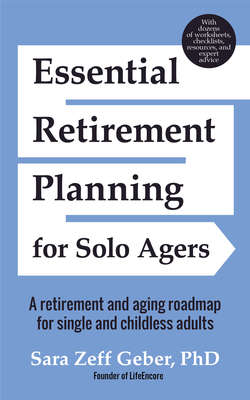Читать книгу Essential Retirement Planning for Solo Agers - Sara Geber - Страница 15
На сайте Литреса книга снята с продажи.
ОглавлениеChapter 4. Happiness and Satisfaction
“Grow old along with me! The best is yet to be.”
—Robert Browning
Adopting a positive attitude toward our own aging, and aging in general, is a key ingredient in happiness and satisfaction in our later years. This positive attitude requires us to see the “retirement” landscape as a blank canvas on which opportunities abound—for personal development, learning, travel, putting ourselves on the market as a “wise elder” (consultant), getting fit and healthy, volunteering for a cause we believe in, and so much more. Without children and grandchildren, you may have more opportunities (and time) for these explorations than your friends who are older parents. Maintaining a positive attitude will also help in the planning.
Planning is difficult, if not impossible, if we dread our future. If we see aging as a time of new horizons and prepare ourselves for the inevitable challenges, we will be in much better shape to face the future. The older we get, the more dramatically our lack of planning in our earlier days shows up. How young and invincible we were! Luckily, planning for our future is always possible. Unless you are reading this book at one hundred (or more) years of age, you still have time to plan—for the next year, the next decade, or the next half of your life. Estate planning, financial planning, and care planning are the big three in the legal arena, but your planning should not end there. You also need to do some planning for your social and community involvement.
Whether you are still pursuing your career dreams, making money part-time, or living in full retirement from the paycheck world, pursuing something that gives your life meaning and purpose is important for everyone. Does it mean you have to fill a fifty-hour week with philanthropy work or volunteer at five different charities? For some, the answer may be a resounding “yes,” but if you cringe at the thought of doing this much “work,” there are endless other possibilities for you to consider, whether you say goodbye to your midlife career at fifty, seventy, or even later.
Our social network is an area of life begging for a better strategy. Planning may seem counter-intuitive in this context, but knowing something about who will be part of our future is critical. In the first half of life we form friendships and connections to people we encounter, people whose values and interests align with ours, people who are engaged with life in a way we want to emulate, and people who appear to enjoy our company and have a similar desire to get closer. When we get closer, we call them “friends.” These people are then in our “inner circle.” Some people have lots of relationships; others select and nurture only a few. At some point, we might transform a relationship into a lifelong partnership or marriage. Also, in our inner circle are family members. For those without children, the inner circle usually includes parents and siblings, and later may include nieces, nephews, and cousins. Most people look at relationships as chance occurrences or serendipity, but I believe we should be more proactive, especially as we get older.
Whether or not you find happiness and satisfaction in the second half of life will depend on how you handle a number of criteria. In my work with people over fifty, I have found there are six important elements to a fulfilling life in later decades:
1.Financial security
2.Commitment to good health and physical well-being
3.Self-awareness
4.Adaptability and flexibility
5.A strong social network
6.Religion, spirituality, or a belief system larger than yourself
I used to include “fun” on the list, but I realized that when my clients could claim they were in possession of all or most of this list, fun naturally followed.
For those who are child-free, some of these six will be more challenging, and some will be less challenging. In the next few chapters, I expand on each of these, in terms of how they relate to those of us without adult children.
